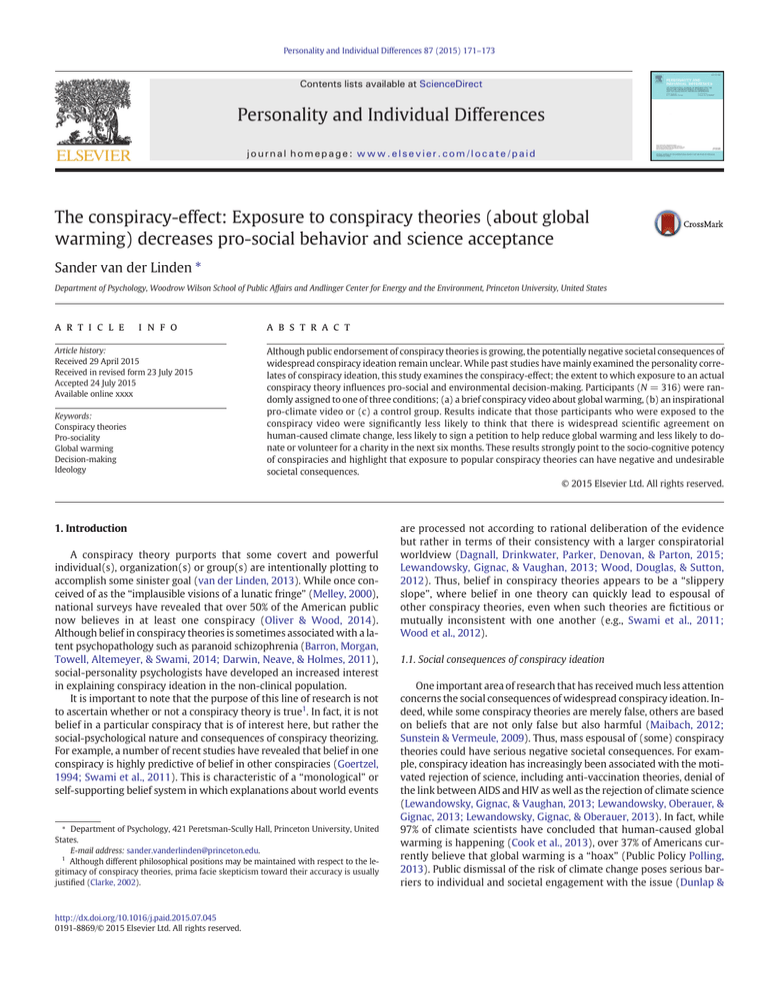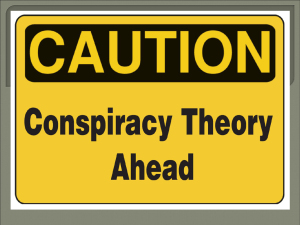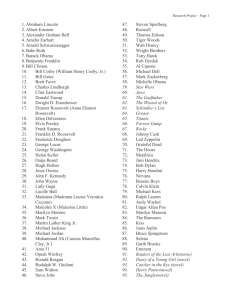
Personality and Individual Differences 87 (2015) 171–173
Contents lists available at ScienceDirect
Personality and Individual Differences
journal homepage: www.elsevier.com/locate/paid
The conspiracy-effect: Exposure to conspiracy theories (about global
warming) decreases pro-social behavior and science acceptance
Sander van der Linden ⁎
Department of Psychology, Woodrow Wilson School of Public Affairs and Andlinger Center for Energy and the Environment, Princeton University, United States
a r t i c l e
i n f o
Article history:
Received 29 April 2015
Received in revised form 23 July 2015
Accepted 24 July 2015
Available online xxxx
Keywords:
Conspiracy theories
Pro-sociality
Global warming
Decision-making
Ideology
a b s t r a c t
Although public endorsement of conspiracy theories is growing, the potentially negative societal consequences of
widespread conspiracy ideation remain unclear. While past studies have mainly examined the personality correlates of conspiracy ideation, this study examines the conspiracy-effect; the extent to which exposure to an actual
conspiracy theory influences pro-social and environmental decision-making. Participants (N = 316) were randomly assigned to one of three conditions; (a) a brief conspiracy video about global warming, (b) an inspirational
pro-climate video or (c) a control group. Results indicate that those participants who were exposed to the
conspiracy video were significantly less likely to think that there is widespread scientific agreement on
human-caused climate change, less likely to sign a petition to help reduce global warming and less likely to donate or volunteer for a charity in the next six months. These results strongly point to the socio-cognitive potency
of conspiracies and highlight that exposure to popular conspiracy theories can have negative and undesirable
societal consequences.
© 2015 Elsevier Ltd. All rights reserved.
1. Introduction
A conspiracy theory purports that some covert and powerful
individual(s), organization(s) or group(s) are intentionally plotting to
accomplish some sinister goal (van der Linden, 2013). While once conceived of as the “implausible visions of a lunatic fringe” (Melley, 2000),
national surveys have revealed that over 50% of the American public
now believes in at least one conspiracy (Oliver & Wood, 2014).
Although belief in conspiracy theories is sometimes associated with a latent psychopathology such as paranoid schizophrenia (Barron, Morgan,
Towell, Altemeyer, & Swami, 2014; Darwin, Neave, & Holmes, 2011),
social-personality psychologists have developed an increased interest
in explaining conspiracy ideation in the non-clinical population.
It is important to note that the purpose of this line of research is not
to ascertain whether or not a conspiracy theory is true1. In fact, it is not
belief in a particular conspiracy that is of interest here, but rather the
social-psychological nature and consequences of conspiracy theorizing.
For example, a number of recent studies have revealed that belief in one
conspiracy is highly predictive of belief in other conspiracies (Goertzel,
1994; Swami et al., 2011). This is characteristic of a “monological” or
self-supporting belief system in which explanations about world events
⁎ Department of Psychology, 421 Peretsman-Scully Hall, Princeton University, United
States.
E-mail address: sander.vanderlinden@princeton.edu.
1
Although different philosophical positions may be maintained with respect to the legitimacy of conspiracy theories, prima facie skepticism toward their accuracy is usually
justified (Clarke, 2002).
http://dx.doi.org/10.1016/j.paid.2015.07.045
0191-8869/© 2015 Elsevier Ltd. All rights reserved.
are processed not according to rational deliberation of the evidence
but rather in terms of their consistency with a larger conspiratorial
worldview (Dagnall, Drinkwater, Parker, Denovan, & Parton, 2015;
Lewandowsky, Gignac, & Vaughan, 2013; Wood, Douglas, & Sutton,
2012). Thus, belief in conspiracy theories appears to be a “slippery
slope”, where belief in one theory can quickly lead to espousal of
other conspiracy theories, even when such theories are fictitious or
mutually inconsistent with one another (e.g., Swami et al., 2011;
Wood et al., 2012).
1.1. Social consequences of conspiracy ideation
One important area of research that has received much less attention
concerns the social consequences of widespread conspiracy ideation. Indeed, while some conspiracy theories are merely false, others are based
on beliefs that are not only false but also harmful (Maibach, 2012;
Sunstein & Vermeule, 2009). Thus, mass espousal of (some) conspiracy
theories could have serious negative societal consequences. For example, conspiracy ideation has increasingly been associated with the motivated rejection of science, including anti-vaccination theories, denial of
the link between AIDS and HIV as well as the rejection of climate science
(Lewandowsky, Gignac, & Vaughan, 2013; Lewandowsky, Oberauer, &
Gignac, 2013; Lewandowsky, Gignac, & Oberauer, 2013). In fact, while
97% of climate scientists have concluded that human-caused global
warming is happening (Cook et al., 2013), over 37% of Americans currently believe that global warming is a “hoax” (Public Policy Polling,
2013). Public dismissal of the risk of climate change poses serious barriers to individual and societal engagement with the issue (Dunlap &
172
S. van der Linden / Personality and Individual Differences 87 (2015) 171–173
McCright, 2011). Although little is currently known about the effect that
conspiracy theories have on pro-social behavior and decision-making,
some preliminary work has alluded to the social consequences of
conspiracism. For example, recent research has shown that reading information about specific conspiracy theories can decrease people's intention to vote and vaccinate (Jolley & Douglas, 2014). Conspiracy
ideation has also repeatedly been associated with high-levels of
distrust, hostility, aggression and right-wing authoritarianism
(Abalakina‐Paap, Stephan, Craig, & Gregory, 1999; Grzesiak-Feldman,
2015). Consequently, it is plausible that conspiratorial thoughts can
make people less pro-social and less willing to contribute to important
societal causes.
public online “stop global warming” petition3. Responses were coded
as (1 = signed) or (0 = did not sign).
2.3.3. Pro-social intent
General pro-social tendencies were assessed with the following two
questions; how likely are you to donate to a charity or charitable
organization in the next six months? How likely are you to volunteer
your time at a local community or charitable organization in the next
six months? (1 = Very unlikely, 7 = Very likely).
2.3.4. Political ideology
Participants were asked the following question; “In general, I think
of myself as” (1 = Very conservative, 4 = Moderate, 7 = Very liberal).
1.2. Current study
The current paper extends this area of research by investigating the
“conspiracy-effect”; the extent to which mere exposure to a conspiracy
theory about an important societal issue (i.e., global warming)
influences (a) people's perception of the level of scientific agreement
on the issue, (b) pro-environmental behavior as well as (c) general
pro-social tendencies.
2.3.5. Manipulation check
Participants answered the follow question; to what extent do you
agree with the following statement; “global warming is a hoax” (1 =
Strongly disagree, 7 = Strongly agree).
3. Results
3.1. Manipulation check
2. Method
2.1. Participants
Study participants were American adults (N = 316) recruited from
Amazon Mechanical Turk (Mturk).2 In total, 131 males and 179 females
participated, ranging between 18 and 65 years of age (modal age
bracket = 25–44). Respondents were invited to participate in an online
survey experiment and paid a small financial reward ($0.50) for
completing the task.
2.2. Materials and procedure
Participants were randomly assigned to either a “conspiracy”,
“pro-climate” or control condition. In the conspiracy condition, participants watched a short 2-minute video clip of a popular conspiracy
movie; “The Great Global Warming Swindle” (Durkin, 2007). In the proclimate condition, participants viewed a 2-minute United Nations
(2009) video clip; “Raise Your Voice about Climate Change”. In the control
group, respondents were asked to solve a neutral word puzzle. Informed
consent was obtained from participants prior to the study. Although respondents were informed that audio/video features must be enabled in
order to participate, six participants were excluded from the analysis because their viewing-records indicated that they did not watch the (entire)
video clip—their exclusion had no bearing on the results.
2.3. Measures
2.3.1. Perceived scientific agreement
Participants' perception of the level of scientific agreement on
climate change was assessed with the following question; to the best
of your knowledge, what % of climate scientists have concluded that
human-caused climate change is happening? (0%–100%).
2.3.2. Pro-environmental behavior
As a measure of pro-environmental behavior, participants were
asked whether they wanted to participate in and personally sign a real
2
Recent evaluations have shown that MTurk samples are more demographically diverse
and at least as reliable as other internet or student-based samples (e.g., Buhrmester, Kwang,
& Gosling, 2011; Mason & Suri, 2012).
A one-way ANOVA indicated a significant main effect for belief that
“global warming is a hoax” between the conditions F(2, 309) = 4.59,
p = 0.01, η2p = 0.03. As expected, participants in the conspiracy condition agreed significantly more with the statement that “global warming
is a hoax” (M = 3.80, SE = 0.20) compared to those in the control condition (M = 3.03, SE = 0.19). Another manipulation check confirmed
that people's answers regarding the content of the videos matched
their treatment group allocation.
3.2. Perceived scientific agreement
A one-way ANOVA revealed a significant main effect for perceived
scientific agreement F(2, 309) = 5.77, p b 0.01, η2p = 0.03. Post-hoc comparisons using the Tukey HSD test indicated a significant difference between the conspiracy (M = 61.32, SE = 2.84) and pro-climate video
(M = 72.44, SE = 2.34) condition (p b 0.01) as well as between the conspiracy and control (M = 70.01, SE = 2.01) condition (p b 0.05). In
other words, participants who were exposed to the conspiracy video
judged the scientific consensus on human-caused climate change significantly lower than those who were not.
3.3. Pro-environmental behavior
In terms of pro-environmental behavior, among those who agreed to
sign the petition, between-group differences were substantial (results
by condition are provided in Table 1). Less than 23% of participants
agreed to sign the petition in the conspiracy-condition vs. 43% in the
pro-climate and 34% in the control group, respectively; χ2(2) = 9.20,
p b 0.01, Cramer's V = 0.17. Between-group comparisons were further
assessed with a simple logistic regression. On average, being in the
conspiracy-condition (vs. the control group), decreased an individual's
odds of signing the petition by 61% (OR = 0.39, SE = 0.13,
Z = −2.91, p b 0.01). The petition (behavior) and scientific consensus
(belief) measures were significantly correlated (r = 0.28, p b 0.01).
3.4. Pro-social intentions
A one-way ANOVA also indicated that exposure to the conspiracy
video had a (marginally) significant effect on pro-social decisionmaking (i.e., combined measure of donating and volunteering), F(2,
3
http://www.stopglobalwarming.org/. A click-thru page verified whether a respondent
actually clicked on the link.
S. van der Linden / Personality and Individual Differences 87 (2015) 171–173
173
Table 1
Pro-environmental behavior (signed/declined) by experimental condition.
Pro-environmental behavior
Pro-climate
(n = 97)
Experimental conditions
Conspiracy
(n = 100)
Control
(n = 113)
Total
(n = 310)
Signed GW petition (n = 88)
Declined (n = 222)
43.18%
26.58%
22.73%
36.04%
34.09%
37.39%
100%
100%
Total
31.29%
32.26%
36.45%
100%
309) = 2.78, p = 0.06, η2p = 0.01. Compared to either the control or proclimate condition, those who were exposed to the conspiracy video
were less likely to have pro-social intentions (M = 4.0, SE = 0.18) vs.
(M = 3.64, SE = 0.17). The pro-environmental behavior and prosocial measures were also moderately correlated (r = 0.29, p b 0.001).
3.5. Political ideology
A logistic regression revealed that political ideology was a significant
predictor of pro-environmental behavior, with a strong negative effect
for conservatives (OR = 0.33, SE = 0.11, Z = −3.32, p b 0.001). Ideology
was not a significant predictor of pro-social intent. No significant
interaction-effect was found between the treatment conditions and political ideology. However, a t-test revealed that, conservatives were significantly more likely than liberals to endorse the statement that “global
warming is a hoax” (M = 3.87, SE = 0.17) vs. (M = 2.18, SE = 0.13),
t(228) = 8.24, p b 0.001.
4. Discussion
This study provided evidence for the “conspiracy-effect”; the finding
that brief, direct contact with conspiracy theories (about global warming)
can be sufficient to significantly decrease pro-environmental decisionmaking, including reduced confidence in the scientific consensus on
climate change. This is important because prior research has shown that
the public's perception of the scientific consensus functions as an important “gateway” cognition that guides other key beliefs about the issue,
such as the belief that climate change is happening, human-caused and
a worrisome problem that requires public action (Ding, Maibach, Zhao,
Roser-Renouf, & Leiserowitz, 2011; Lewandowsky et al., 2013b; van der
Linden, Leiserowitz, Feinberg, & Maibach, 2015). Moreover, this study
finds that briefly exposing the public to conspiratorial thoughts about a
specific issue may even decrease general pro-social tendencies. These
findings are consistent with other recent research that has alluded to
the notion that conspiracy ideation can lead to the motivated rejection
of science and decreased civic engagement (Jolley & Douglas, 2014;
Lewandowsky et al., 2013a, 2013c).
Although conspiracy theorizing has been observed across the entire
political/ideological spectrum (Oliver & Wood, 2014), it is welldocumented that organized climate change denial is especially predominant among right-wing, conservative Republicans (Dunlap & McCright,
2011; Dunlap & Jacques, 2013; Lewandowsky, Gignac and Oberauer,
2013; Lewandowsky, Gignac and Vaughan, 2013; Lewandowsky,
Oberauer, et al., 2013). Consistent with prior research, this study generally finds that compared to liberals, conservatives were more likely to
believe that global warming is a hoax and accordingly, less likely to
sign a petition to help stop global warming. Interestingly, no significant
interaction was found between the treatment conditions and political
ideology, which could be explained by the fact that perhaps conservatives were already likely to hold some conspiratorial views about global
warming. After watching the conspiracy video, conservatives and liberals were equally (less) likely to donate or volunteer for a charity. In
conclusion, this research illustrates that researchers and policy-makers
should not underestimate the socio-cognitive potency of conspiracies,
as growing public belief in and potential exposure to conspiracy
theories can have negative and undesirable societal consequences.
Appendix A. Supplementary data
Supplementary data to this article can be found online at http://dx.
doi.org/10.1016/j.paid.2015.07.045.
References
Abalakina‐Paap, M., Stephan, W. G., Craig, T., & Gregory, W. L. (1999). Beliefs in conspiracies. Political Psychology, 20(3), 637–647.
Barron, D., Morgan, K., Towell, T., Altemeyer, B., & Swami, V. (2014). Associations between
schizotypy and belief in conspiracist ideation. Personality and Individual Differences,
70(156), 159.
Buhrmester, M., Kwang, T., & Gosling, S. D. (2011). Amazon's Mechanical Turk: A new
source of inexpensive, yet high-quality data? Psychological Science, 6(1), 3–5.
Clarke, S. (2002). Conspiracy theories and conspiracy theorizing. Philosophy of the Social
Sciences, 32(2), 131–150.
Cook, J., Nuccitelli, D., Green, S. A., Richardson, M., Winkler, B., Painting, R., et al. (2013).
Quantifying the consensus on anthropogenic global warming in the scientific literature. Environmental Research Letters, 8(2), 024024.
Dagnall, N., Drinkwater, K., Parker, A., Denovan, A., & Parton, M. (2015). Conspiracy theory
and cognitive style: A worldview. Frontiers in Psychology, 6(206)http://dx.doi.org/10.
3389/fpsyg.2015.00206.
Darwin, H., Neave, N., & Holmes, J. (2011). Belief in conspiracy theories. The role of paranormal belief, paranoid ideation and schizotypy. Personality and Individual Differences,
50(8), 1289–1293.
Ding, D., Maibach, E. W., Zhao, X., Roser-Renouf, C., & Leiserowitz, A. (2011). Support
for climate policy and societal action are linked to perceptions about scientific
agreement. Nature Climate Change, 1, 462–465.
Dunlap, R. E., & Jacques, P. J. (2013). Climate change denial books and conservative think
tanks: Exploring the connection. American Behavioral Scientist, 57(6), 699–731.
Dunlap, R. E., & McCright, A. M. (2011). Organized climate change denial. In J. S. Dryzek, R.
B. Norgaard, & D. Schlosberg (Eds.), The Oxford Handbook of Climate Change and
Society (pp. 144–160). Oxford, UK: Oxford University Press.
Durkin, M. (2007). The great global warming swindle. (Director) UK: Motion Picture.
Goertzel, T. (1994). Belief in conspiracy theories. Political Psychology, 15(4), 731–742.
Grzesiak-Feldman, M. (2015). Are the high authoritarians more prone to adopt conspiracy theories? In M. Bilewicz, A. Cichocka, & W. Soral (Eds.), The psychology of conspiracy (pp. 99–117). New York, NY: Routledge.
Jolley, D., & Douglas, K. M. (2014). The effects of anti-vaccine conspiracy theories on vaccination intentions. PLoS ONE, 9(2) e89177.
Lewandowsky, S., Gignac, G. E., & Oberauer, K. (2013a). The role of conspiracist ideation
and worldviews in predicting rejection of science. PLoS One, 8(10) e75637.
Lewandowsky, S., Gignac, G. E., & Vaughan, S. (2013b). The pivotal role of perceived
scientific consensus in acceptance of science. Nature Climate Change, 3(4), 399–404.
Lewandowsky, S., Oberauer, K., & Gignac, G. (2013c). NASA faked the moon landing:
Therefore, (climate) science is a hoax: An anatomy of the motivated rejection of science. Psychological Science, 24(5), 622–633.
Maibach, E. (2012). Knowing our options for setting the record straight, when doing so is
particularly important. Psychological Science in the Public Interest, 13(3), 105.
Mason, W., & Suri, S. (2012). Conducting behavioral research on Amazon's Mechanical
Turk. Behavior Research Methods, 44(1), 1–23.
Melley, T. (2000). Empire of conspiracy: The culture of paranoia in postwar America. Ithaca,
NY: Cornell University Press.
Oliver, J. E., & Wood, T. J. (2014). Conspiracy theories and the paranoid style(s) of mass
opinion. American Journal of Political Science, 58(4), 952–966.
Polling, Public Policy (2013). Conspiracy theory poll results. Available at: http://www.
publicpolicypolling.com/main/2013/04/conspiracy-theory-poll-results-.html
Sunstein, C. R., & Vermeule, A. (2009). Conspiracy theories: Causes and cures. Journal of
Political Philosophy, 17(2), 202–227.
Swami, V., Coles, R., Stieger, S., Pietschnig, J., Furnham, A., Rehim, S., et al. (2011). Conspiracist ideation in Britain and Austria: Evidence of a monological belief system and
associations between individual psychological differences and real‐world and
fictitious conspiracy theories. British Journal of Psychology, 102(3), 443–463.
United Nations (2009). Raise your voice about climate change [Youtube broadcast].
van der Linden, S. (2013). What a hoax: Why people believe in conspiracy theories.
Scientific American Mind, 24(4), 41–43.
van der Linden, S., Leiserowitz, A., Feinberg, G., & Maibach, E. (2015). The scientific
consensus on climate change as a gateway belief: Experimental evidence. PLoS ONE,
10(2) e0118489.
Wood, M. J., Douglas, K. M., & Sutton, R. M. (2012). Dead and alive: Beliefs in contradictory
conspiracy theories. Social Psychological and Personality Science, 3(6), 767–773.



